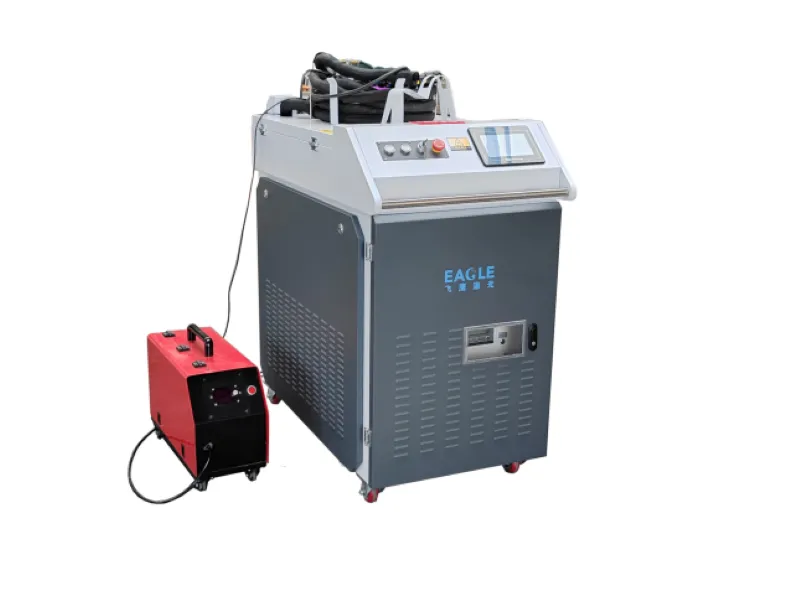Welding technology is widely used in the manufacturing industry, and it is almost an indispensable and important processing process in the modern manufacturing industry. It plays a key role in many fields. For the welding of thin plates and thick plates, the welding technology selected is different, and the choice of welding machine is also different. Today we will introduce to you the difference between handheld laser welder and traditional welding machines.
Handheld laser welder VS Traditional welding:
Handheld laser welder uses a high-energy-density laser beam to focus on the surface of the material through an optical system, so that the material instantly melts or vaporizes to form a bath for welding; Traditional welding relies on heat sources such as arc and flame to heat the base material and the welding material, and the bath is formed by melting and mixing, and the weld is generated after cooling. The core difference between the two is that laser welding uses precisely focused light energy as the heat source, with concentrated energy and a small heat-affected area; Traditional welding uses diffuse heat sources (such as arcs) as the main source, which has wide applicability but a large heat input range.
Handheld laser welder performance characteristics:
As an emerging welding technology, handheld laser welder has extremely fast welding speed, which can reach 2-10 times that of traditional welding. It is particularly suitable for high-volume and continuous production scenarios, such as automotive or electronic manufacturing assembly lines, which can significantly increase production capacity and reduce downtime. The heat-affected zone is very small and the heat is highly concentrated. Handheld laser welder effectively reduces material deformation, cracking and oxidation problems, making the welding process more stable and reliable.

In terms of operational flexibility, the design of handheld laser welder allows welders to work hand-held, which allows us to handle complex or irregularly shaped workpieces more flexibly and conveniently, and supports long-distance welding (such as outdoor or remote environments) without the need for a fixed workbench, which greatly expands the applicable scenarios. In terms of weld quality, our handheld laser welder can form welds with a high aspect ratio (deep and narrow structure), which not only improves the welding strength and sealing, but also makes the weld surface flat and beautiful. There is usually no need or only a small amount of subsequent polishing and polishing, saving additional processing costs and time. In terms of equipment composition, our handheld laser welder integrates core modules such as lasers, intelligent control systems, and cooling systems. From the perspective of long-term operations, its high efficiency (such as reducing rework) and high-quality output can significantly reduce overall production costs.
Safety performance is the outstanding advantage of handheld laser welder. Although the laser beam energy is high, the operation is simple and intuitive, and the protective design ensures that it is harmless to the operator's eyes and skin, and improves the safety of the working environment.It has a wide range of applications. Handheld laser welder is suitable for stainless steel plates, iron plates, galvanized sheets and other metal materials. It is widely used in high-end industries such as automobile manufacturing (such as body welding), aerospace (connection of aircraft components), electronic equipment (precision circuit boards) and medical devices (assembly of surgical instruments) to promote industrial upgrading. Overall, handheld laser welder, with its comprehensive performance, is becoming an indispensable tool for modern industry.
Traditional welding performance characteristics:
As a basic industrial technology, traditional welding has a relatively slow welding speed, especially when dealing with complex shapes (such as curved surfaces or fine structures) or thin sheet materials, which require finer operations and repeated heating, resulting in reduced production efficiency. For example, in automotive or electronic assembly, the construction period may be extended.
In terms of consumables, traditional welding equipment uses a large amount of consumables, including welding rods, welding wires, protective gases and other key materials. This not only increases the cost of raw materials, but also because burrs or uneven surfaces may occur after welding, additional manual polishing, polishing and other follow-up processing are required, which increases the overall processing cost and time investment.
In terms of safety performance, the traditional welding operation process will release potential risks such as high temperature, harmful smoke, and strong arc light. Operators must take strict safety measures, such as wearing protective gloves, masks, and ventilation equipment, to avoid burns or health hazards, which increases training and management costs. Despite these challenges, traditional welding is widely applicable and can be applied to various materials (such as steel and aluminum alloys) and thicknesses (from thin plates to thick plates), especially suitable for general manufacturing (such as the production of mechanical parts), the construction industry (steel structure construction) and repair work (equipment maintenance). Its flexibility and mature technology make it still advantageous among small and medium-sized enterprises. Overall, although traditional welding has low efficiency and high safety requirements, it continues to serve many industrial fields due to its stability and versatility.

